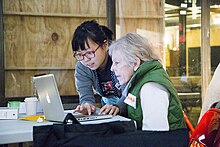Youth-adult partnership is a conscious relationship that establishes and sustains intergenerational equity between young people and adults. Youth-adult partnerships often display a high degree of youth rights and autonomy, and is often synonymous with meaningful youth participation. Typically seen with adults acting in a mentor capacity, providing scaffolding to the youth. Unlike traditional mentoring, youth-adult partnerships are categorized by multiple adults and multiple youth[1] and there must also be a mutuality where adults and youth teach and learn from one another, working together in their community.[2]

Factors for Success
editThe success of these partnerships rely on a variety of factors. In addition to concrete outcomes, youth/adult partnerships require specific cultural and structural supports within organizations and communities in order to succeed.[3]
There needs to be mutual respect and cohesiveness within members of the partnership. [4]
Common Settings
editThese relationships usually occur within youth organizations, where they are typified by youth voice. Youth voice is commonly recognized as an essential element of effective youth-adult partnerships.
Schools
editIn democratic schools, they are typified by student voice. One of the expectations from these youth-adult partnerships is that the student-led groups can represent the student body to the administration and school boards. [2] This can be done in a variety of different ways, such as planning activities, cocreating curriculum, and assessing progress and current effectiveness of programs within the school. [2]
Communities
editYouth-adult partnerships can empower youth and adults as they educate their peers and advocate for the promotion of health and active engagement in the community.[4]
Outcomes
editYouth-adult partnerships allow young people to:
- Express their views and raise awareness for social issues publicly [2]
- Gain respect for adult allies[2]
- Find ways to express their creativity
- Work for a good cause
- Think more critically
- Be a valued asset to the project and the community[5]
- Raise issues that adults may be avoiding, or unaware of.[2]
The relationships formed by youth-adult partnerships combat ephebiphobia and adultism by elevating the role of youth voice. [6]
A broad number of parties benefit from said partnerships, including the organizations where the partnerships occur, and the adults and youth who are involved.[1] Actual benefits range from increased commitment, to higher feelings of self-efficacy,[7] as well as increased organizational effectiveness and civic engagement.[8] Youth-adult partnerships have been found to be particularly effective in addressing school improvement,[9][2] promoting Global Health Initiatives,[10] and integrating technology in the classroom.[11]
According to the State of Texas, youth-adult partnerships have allowed young people to assume the roles of advisors and consultants to youth organizations, political lobbyists, community organizers, grant (money) decision-makers, nonprofit board directors, and as direct youth service providers.[12] Additional practice has identified significant roles for youth-adult partnerships in rural civic engagement projects[13] and in creating effective outreach for lesbian, gay, bisexual, transgender, queer, and questioning youth.[14]
See also
editReferences
edit- ^ a b Zeldin, S., McDaniel, A., Topitzes, D., & Lorens, M.B. (2001). "Bringing young people to the table: Effects on adults and youth organizations," CYD Journal, 2(2) p. 20-27.
- ^ a b c d e f g Mitra, Dana L. (May 2009). "Collaborating with Students: Building Youth-Adult Partnerships in Schools". American Journal of Education. 115 (3): 407–436. doi:10.1086/597488. ISSN 0195-6744. S2CID 145602508.
- ^ Zeldin, S. and Petrokubi, J. (2006) "Understanding Innovation: Youth-Adult Partnerships in Decision Making," The Prevention Researcher. 131. Pages 11-15.
- ^ a b Brown, Louis D.; Redelfs, Alisha H.; Taylor, Thomas J.; Messer, Reanna L. (September 2015). "Comparing the Functioning of Youth and Adult Partnerships for Health Promotion". American Journal of Community Psychology. 56 (1–2): 25–35. doi:10.1007/s10464-015-9730-2. PMC 4620943. PMID 26066568.
- ^ (n.d.)Dialogues Across Nebraska: Youth Adult Partnerships[permanent dead link] University of Nebraska Rural Initiative.
- ^ Fletcher, A. (2006) Washington Youth Voice Handbook. Olympia, WA: CommonAction.
- ^ To, Siu-ming; Chun-Sing Cheung, Johnson; Liu, Xiaoyu; Lau, Cheryl Danielle; Zeng, Hera Junfei; Chan, Adam Man-yuk (2020-06-10). "Youth Empowerment in the Community and Young People's Creative Self-Efficacy: The Moderating Role of Youth–Adult Partnerships in Youth Service". Youth & Society. 53 (6): 1021–1043. doi:10.1177/0044118x20930890. ISSN 0044-118X. S2CID 225757865.
- ^ Norman, J. (2001) "Building Effective Youth-Adult Partnerships", Transitions. 141, October 2001. Advocates for Youth.
- ^ Fletcher, A. (2005) Meaningful student involvement guide to students as school partners. Bothell, WA: HumanLinks Foundation.
- ^ Family Health International. (2002) YouthLens: Youth-Adult Partnerships Network. 222. Author.
- ^ Goldman, G. & McCombs, B. (n.d.) Using New Educational Technologies to Empower Youth: The Power of Youth-Adult Partnerships in e-Learning Archived September 29, 2006, at the Wayback Machine. Seattle, WA: New Horizons for Learning.
- ^ (2002) Youth/Adult Partnerships Guide Archived June 14, 2006, at the Wayback Machine Texas Network of Youth Services and Prevention and Early Intervention/Community Youth Development, Division of the Texas, Department of Protective and Regulatory Services.
- ^ (n.d.)Civic Engagement and Youth/Adult Partnerships Archived September 29, 2006, at the Wayback Machine Arlington, VA: Rural School and Community Trust.
- ^ (n.d.) GLSEN Jump Start: Youth Adult Partnerships Archived September 27, 2007, at the Wayback Machine New York, NY: GLSEN.
External links
edit- Youth/Adult Partnerships Factsheet University of Arizona website.
- Youth/Adult Partnerships Tip Sheet The Freechlid Project.
- SpunOut.ie National Youth Website, Ireland.